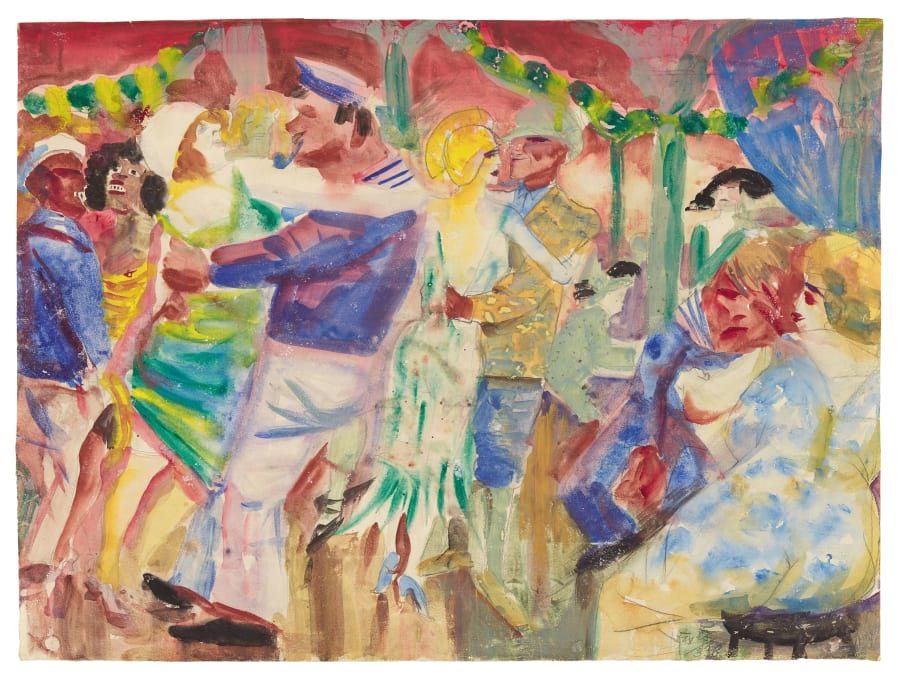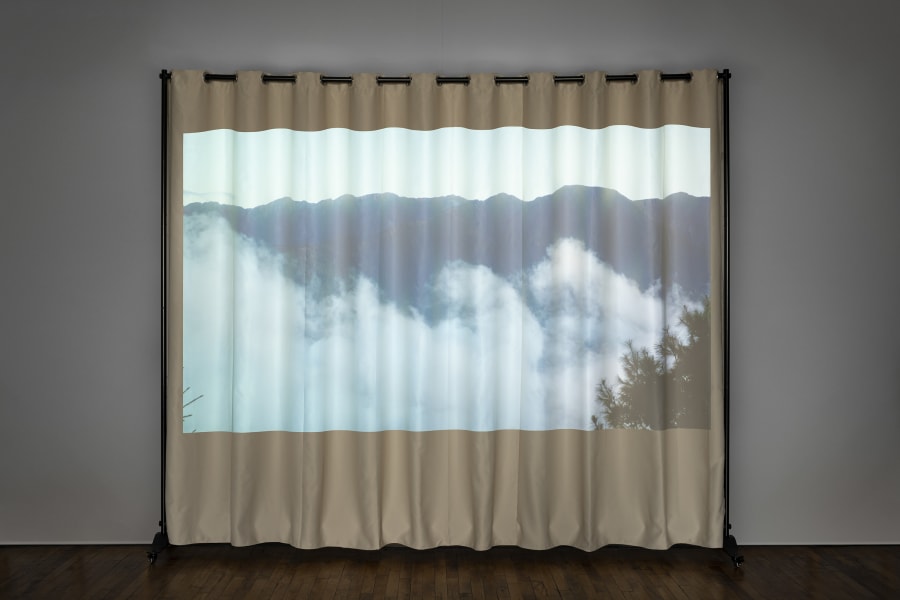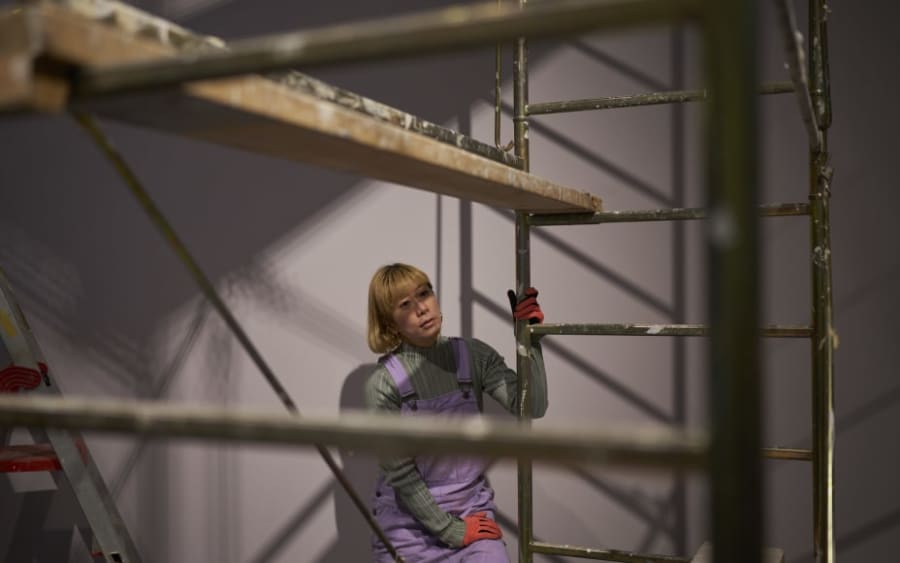In the painting The Banjo Lesson (1893) by Henry Ossawa Tanner, a child and an elderly gentleman share a tender moment in a kitchen, the boy seated on the lap of his uncle, who is teaching him how to play the instrument. Tanner painted the sentimental moment to counteract the distorted, caricature-like imagery that surrounded African Americans and which fomented regressive policies meant to undermine Reconstruction – among them a series of five Supreme Court rulings in 1883 that overturned protections against discrimination, ushering in the Jim Crow era. With its political leanings, the painting remains undeniably reverential, representing an intergenerational dialogue that reverberated among Tanner’s successors. It situates Black figurative painters among a pantheon of artists who aligned their work with social movements that directly challenged stereotypes with countervailing images of Black life.
As contemporary Black figurative artists steadily garner more attention, curators and historians look to present these works in conversation with their predecessors in a more geographically expansive, historical, and generational context. This spring, the Kunstmuseum Basel hosts the second iteration of ‘When We See Us: A Century of Black Figuration in Painting 1924–2024,’ an extensive exhibition featuring more than 120 global artists whose work foregrounds the quiet pleasures of the quotidian in their artistic representations of Black life. Reflecting a century of figurative work, the show plants Black figuration in a timeline that claims space for artists who were long overlooked. In other words – we’ve been here all along, despite insinuations that Black portraiture is presently having a moment.
The dictates of Black visibility have long been determined by the majority, who firmly situate Blackness in a state of hypervisibility or invisibility, being surveilled and ignored. Over time, numerous artistic and activist movements have aligned to counter social programming that views Blackness through a lens of racism, violence, trauma, and caricature. In response, Black artists have asked, who and what do we see when we see ourselves? This inquiry lies at the root of ‘When We See Us’; the title is a semantic variant of the 2019 Netflix docuseries by Ava DuVernay, ‘When They See Us’. The ‘We’ and ‘They’ signal a shift in gaze that artists including Mickalene Thomas have deployed to challenge objectified renderings of Black women through multifaceted depictions of agency, self-possessiveness, and sexuality in the case of Thomas’s portraits. Indeed, as Thomas once reflected in an interview, ‘So often there are so many other images that look at us as the other in a negative light, so for me it’s a way of celebrating who we are.’
The Zeitz Museum of Contemporary Art Africa in Cape Town, South Africa, hosted the original iteration between 2022 and 2023, and Executive Director and Chief Curator Koyo Kouoh used six themes as the exhibition’s point of departure: The Everyday; Joy and Revelry; Repose; Sensuality; Spirituality; and Triumph and Emancipation. Celebrating artists from Africa and across the diaspora, the show prompts a unique call to contemplation and action: to challenge the expectations and assumptions around race, gender expression, sexuality, and identity, and to critically examine how perceptions around superiority formed those assumptions. By removing the tether of trauma, curators have isolated their focus on artists who allow for joy, but also reflection and introspection, in all its variants.
Within this schematic, artist Toyin Ojih Odutola is a world-maker. Her drawings refuse to be defined by time or space. Instead, she renders her subjects within the imaginary worlds they inhabit. Her 2018 series features the aspirational (and fictional) Omodele family, who hail from her home country of Nigeria. In Picnic on the grounds (2017–18), a mother and daughter enjoy an afternoon on a breezy, bucolic hillside – it’s a piece I regularly turn to when I need to daydream. In current works, her pen conjures introspection and vulnerability in intricate lines that examine transparency. In Enter Password (2023), her subject stands guard in front of a window protecting someone behind them. Ojih Odultola renders the waves of the reflection in the glass in charcoal, creating a transparent line that also extends to the subtle reflection of the sheer apparition appearing within the intricate shirt folds of her subject.
Lynette Yiadom-Boakye also rejects the space-time continuum. Her subjects are imagined portraits, a convention that suits the artist, who is also a prolific writer. The paintings are devoid of any superfluous detail, allowing the artist and viewer to focus squarely on the depicted figure. In Brothers to a Garden (2017) from her 2020 show at the Huntington in Pasadena, California, her subject is wistfully absorbed in their own thoughts, as if they are a surrogate for the artist’s own creative rumination: ‘do I paint this idea or do I write about it?’ They are quiet, profoundly intimate moments of introspection.
Danielle Mckinney paints solitude in its most raw, unapologetic, and glamorous forms. It takes a high level of confidence to enjoy one’s own company, and Mckinney captures a deep level of functional introversion. Her women are suspended in moments of repose; their stillness is interrupted by smoldering curls of smoke. She uses sumptuous mahogany tones, dark olive greens, and rich browns illuminated by an amber light. They are women who delight in a good book and a glass of wine; they live with a Picasso or a Matisse hung over their lush velvet couch where they lie in silk robes with their hair wrapped in white terry towels. Mckinney subverts the trope of the Black woman as a caregiver; suggesting that rather than relying on Black women to save the world, her portraits teach us to nurture and save ourselves, reminding us, as Audre Lorde noted in A Burst of Light (1988), that ‘caring for myself is not self-indulgence, it is self-preservation, and that is an act of political warfare.’
As novelist Ken Bugul notes in an excerpt from the show’s catalog, ‘When in solitude, we sit, stare, dream, and introspect… This is the dreamscape for the slow wondrous living, for radical self-preservation, for mind-body-soul connection, and for unapologetic rest.’ These figurative works represent a fraction of the many expressions of our embodied experiences with identity and visibility. The absence of an overtly moral or political imperative or an attachment to conflict or critique doesn’t limit the exhibition’s scope or minimize its reach. No movement or moment will be all-encompassing, however, these artists show us how to dream and imagine so that we are better equipped to align our energy toward meaningful connection with others. That connection begins with an awareness of self.
Artist Laura Wheeler Waring was born seven years before Tanner painted The Banjo Lesson, and she became one of the Harlem Renaissance’s most influential portrait painters. As an illustrator and commissioned artist whose subjects were largely monied, one of her most noted works featured Anna Washington Derry, a laundress close to the artist’s family who was freed from slavery as a teenager. Using a muted tonal palette, Wheeler Waring renders the quiet power of the sitter, capturing the soft lines on her forehead and her side-cast gaze. The piece stands out for its singular focus and uplift of a Black woman by a Black woman, creating a shift in gaze that exhibitions like ‘When We See Us’ also elicit.
I grew up with a copy of Tanner’s The Banjo Lesson in my parents’ home; I was not attuned to the work’s historical significance, but it was a reflection of resilience, nurture, and love – and most importantly, it was a reflection of me. Exhibitions that reinforce what the curators of ‘When We See Us’ call the ‘multiplicity of Blackness’, remain vitally important affirmations of our visibility in all of its complex, beautiful representations.
Danielle Mckinney is represented by Marianne Boesky Gallery, New York.
Toyin Ojih Odutola and Lynette Yiadom-Boakye are represented by Jack Shainman Gallery, New York.
Mickalene Thomas is represented by Kavi Gupta, Chicago, Lehmann Maupin, New York and London, and Galerie Nathalie Obadia, Paris and Brussels.
Works by these artists will be on view in the Galleries sector of the next edition of Art Basel in Basel, from June 13 to 16, 2024.
‘When We See Us. A Century of Black Figuration in Painting’
Kunstmuseum Basel
From May 25 to October 27, 2024
Colony Little is a writer and critic based in Raleigh, North Carolina. She is the founder of Culture Shock Art, a contemporary art blog dedicated to amplifying the voices of Black artists and artists of color. In 2020 she was a recipient of the Andy Warhol Foundation Arts Writers Grant.


